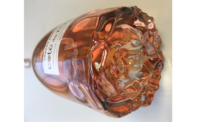Materials Technology: Beverage Packaging
A picture speaks a thousand words
How advanced package printing is empowering brands in the battle to attract consumer loyalty and stand out in the retail environment- A Q&A with Crown Beverage Packaging North America.


|
| In addition to being a reliable and sustainable packaging format, metal is also visually beautiful and exciting, and can easily be enhanced to entice consumers with a unique look and feel. |
When it comes to distinguishing beverage products on store shelves, unique and high quality printing is one means to attract attention and connect with consumers. Advanced printing technologies are now paving the way for greater creativity – and brand enhancement. We recently spoke with Paul Fennessy, senior manager of graphics for CROWN Beverage Packaging North America, a business unit of Crown Holdings, Inc. (Crown; www.crowncork.com), to discuss how printing can help beverage brands strengthen their image and make a lasting first (and second) impression with finicky consumers.
Food and Beverage Packaging: What role does visual appeal play when consumers are making purchasing decisions?
Fennessy: In a global marketplace where brands are competing for consumer attention as well as shelf space, the visual aspects of a package are extremely important. In stores, a consumer’s first experience with a product – and its packaging – is visual. Appealing graphics and colors are an effective strategy, serving to distinguish brands, create a unique perception of a product and, ultimately, keep it at the top of consumers’ minds. Market research shows, for example, that color increases brand recognition by as much as 80%, which in turn can be linked directly to consumer confidence.
There are a number of ways that brands can apply this data to beverage cans. In addition to being a reliable and sustainable packaging format, metal is also visually beautiful and exciting, and can easily be enhanced to entice consumers with a unique look and feel. Beverage cans are printed with precision and accuracy, supporting brand goals through visual design and creating a distinctive packaging experience for any occasion or event.
FBP: From your perspective as a can manufacturer, how have the printing and decorating options available to brand owners grown over time?
Fennessy: Brand owners have more options available to them today than ever before, from high resolution printing of graphics to the use of specialty metallic and marble effects. Whether it’s embossing, employing tactile finishes or simply the overall print quality, packaging now more than ever is able to help beverage brands stand out.
With all of these options, it’s imperative for brands to collaborate with their packaging supplier creatively, as well as technically, on a design to achieve the best final output. Packaging partners should be able to offer printing recommendations that best support a brand’s objectives and achieve the desired visual effect. Making sure that the design parameters are met, and that colors and finishes on the metal package are exactly as intended, also establishes the groundwork for consistent quality across the entire print run, which builds brand recognition and trust in the minds of consumers.
FBP: So what needs to be considered when developing graphics for beverage cans?
Fennessy: Brand owners should be aware of the advanced printing techniques used today. For example, printers may employ a secondary blend of inks to enhance specific colors on the package, creating a final product that is visually stunning and unique. Technologies like these can greatly improve the clarity, accuracy and precision of the final printed image on the package - qualities that are necessary to keep a brand visually consistent and assure consumers that they are buying the product they want.
One key aspect of printing is image resolution, and today, we can achieve far higher quality and consistency of printing at high resolutions. Technologies like Pictoris™, Crown’s high quality print process, enhance the visual appeal of a design through proprietary separation techniques for improved dot spacing and superior reproduction of fine details.
It is also important to manage other aspects of the printing process, such as maintaining the proper film weight, which directly affects the amount of ink used to create an image on the can. An improper film weight may result in smudging of the image or the inadvertent blending of colors at one extreme and illegible color fading at the other.
FBP: Do special considerations need to be taken into account when adapting a design to be printed on the curved surface of a can?
Fennessy: Absolutely. At the start of any project, our first step is to evaluate the graphics and make recommendations for enhancing the size, quality, colors and so forth. Scaling and balancing images for a rounded surface requires an extra layer of quality assurance. Much of this has to do with transitioning the initial two-dimensional design concept to the three dimensions of a beverage can. Your supplier will work with you to facilitate this transition and can use its experience to identify potential difficulties on the printing press. It can also make recommendations to resolve them so that the final package is of the best possible quality.
Once the desired parameters have been achieved and the final design approved, a color separation is provided to the printer. Package mock-ups are created so that customers can quickly and accurately evaluate how the final design will look when printed on metal.
FBP: How does a brand know it’s choosing the best packaging supplier for its product?
Fennessy: From concept to output, the quality of a package is in many ways only as good as the support of your supplier. As mentioned earlier, a package’s impact is influenced by the quality of the design separations, color matching and of course the original image selection. Your supplier’s experience will undoubtedly help in the initial stages of the design’s conception, all the way through to providing recommendations for maximizing efficiencies on the press and anticipating printing challenges before they happen. This can reduce delays due to print errors and ultimately deliver a quality package. At the same time, it is important to make sure that you are working with a partner that has a responsive customer service system in place, so that it can meet your needs, make any changes efficiently and help you avoid losing time on reprints.
Paul Fennessy,
Senior Manager, Graphics
Fennessy has over 20 years experience in the areas of graphic design, printing and customer service. Prior to Crown, he held a Director of Operations position at a local pre-press firm in Ft. Washington, PA, as well as an Art Director position for a publisher in Center City, Philadelphia.
About Crown Holdings, Inc.
Crown Holdings, Inc., through its subsidiaries, is a leading supplier of packaging products to consumer marketing companies around the world. World headquarters are located in Philadelphia, PA.
Looking for a reprint of this article?
From high-res PDFs to custom plaques, order your copy today!








